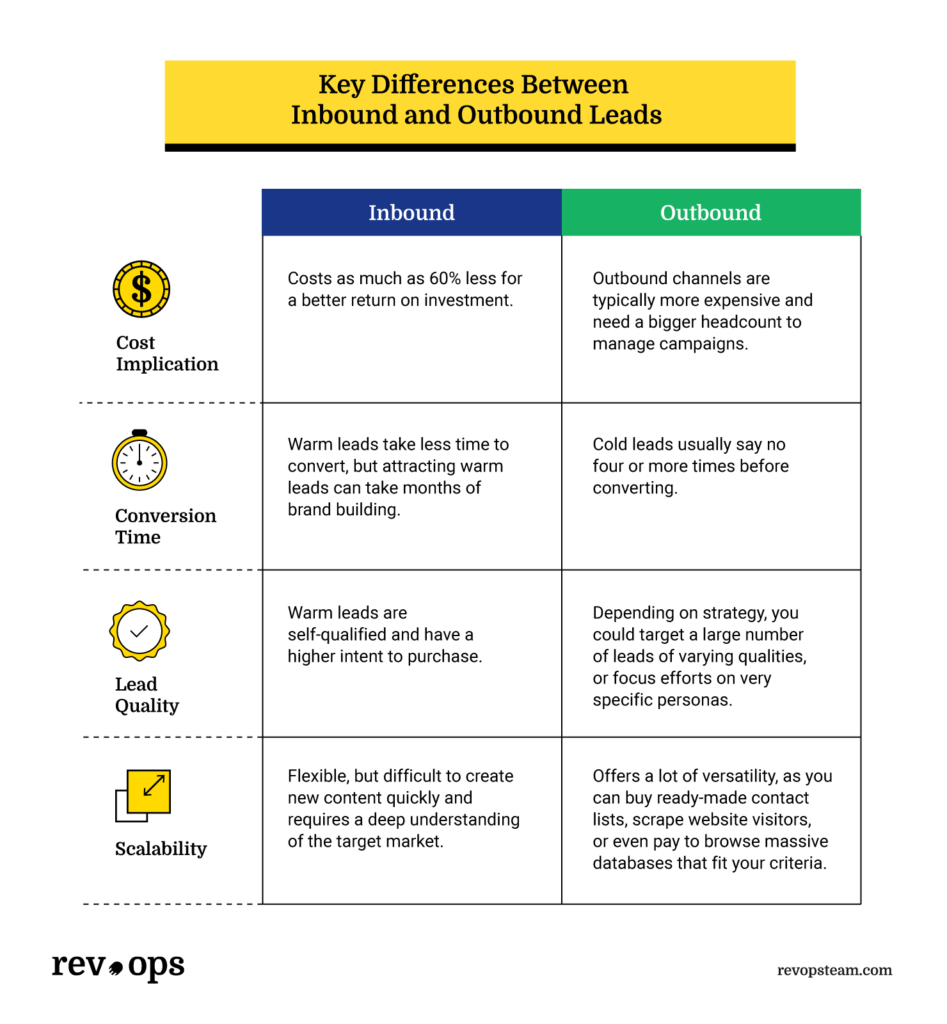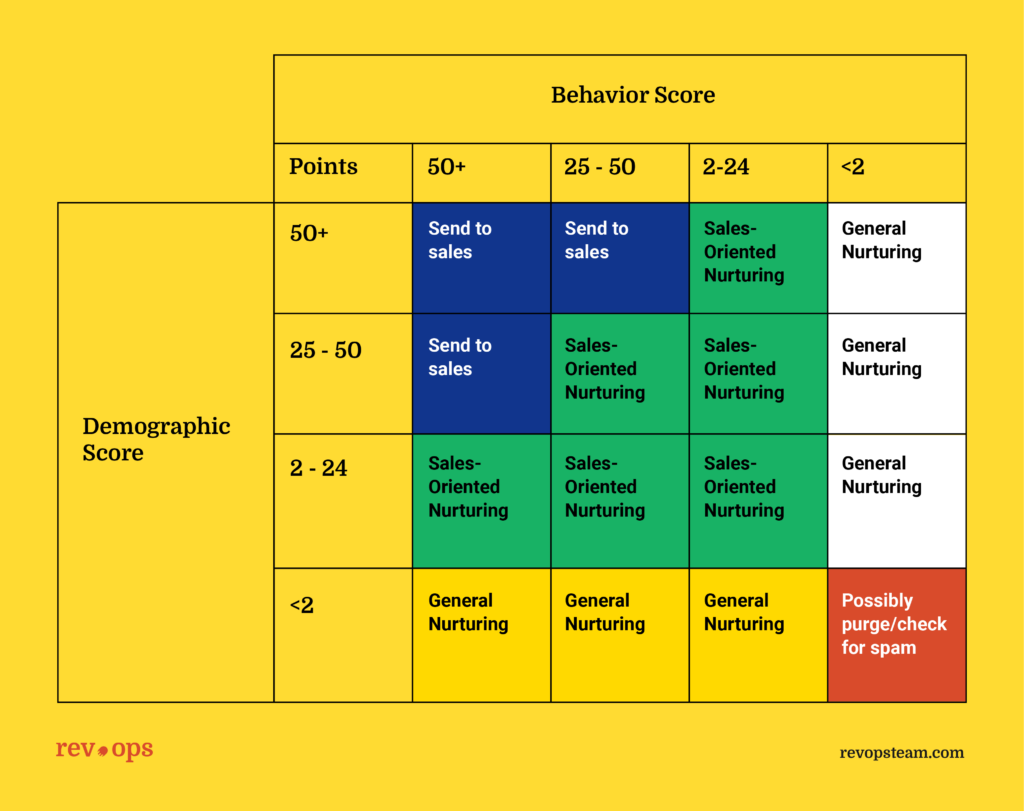Lead Conversion Reality: Generating leads is crucial for a reliable revenue engine, but with a median conversion rate of just 3%, expect only 3 out of every 100 leads to become paying customers.
Lead, Prospect, or Opportunity?: Leads show initial interest, prospects are qualified buyers, and opportunities are highly qualified individuals nearing a decision to purchase.
Hot, Warm, or Cold?: Categorize leads by their interest level—hot leads are ready to buy, warm leads need more info, and cold leads require significant nurturing.
A+ Leads: Marketing Qualified Leads (MQLs) have shown genuine interest but aren’t ready to speak with sales; they need nurturing to guide them through the funnel.
Inbound Meets Outbound: Successful lead generation uses both organic inbound marketing (like social media posts) and paid outbound tactics (like PPC ads) to attract potential customers.
To build a reliable revenue engine, you need a lot of leads. In SaaS, the median conversion rate across all subcategories is 3%, according to Inturact. So for every 100 leads in your funnel, only 3 will become paying customers. Yikes.
This article will give you a quick background on marketing leads, exploring what they are and how to generate, qualify, and ultimately convert them into loyal customers.
What Is A Lead In Marketing?
A lead is an individual or business that has shown interest in your product or service.
"Interest" can be defined in a few ways, but usually it means interaction with marketing materials like filling out a contact form on a landing page, subscribing to a newsletter, or requesting a quote from an email marketing CTA.
Lead vs. Prospect vs. Opportunity
While they may seem interchangeable, these three terms refer to different stages of the sales funnel or buyer's journey and are all treated a bit differently.
- Lead: This is someone at the top of the funnel who’s shown some interest in your company, but you're not quite sure yet if they’re a good fit as a potential customer.
- Prospect: Now we’re in the middle of the funnel. A prospect is someone you've qualified as an ideal buyer— aka someone who could really benefit from what you're offering.
- Opportunity: At the bottom of the funnel, we have an opportunity. This person is highly qualified, and there’s a strong chance they’ll become a paying customer.
Types Of Leads
A lead is actually a pretty broad term. You can group and segment your leads even further based on how familiar they are with your company, how they got on your radar, or a number of other factors.
But these are some of the most common ways to categorize leads in your lead management strategy.
Cold, Warm, and Hot Leads

The simplest way to categorize leads is based on their level of interest and readiness to buy using a temperature scale:
- Hot leads: These folks are actively looking for a solution to their problem and are ready to buy right now. They’re highly interested and have already done a lot of research.
- Warm leads: These people are definitely interested in what you’re offering, but they’re still weighing their options. They might need a little more info or a nudge before they’re ready to commit.
- Cold leads: These are the people who barely know your business or product exists. They’ll need a lot of nurturing before they’re likely to become potential customers.
Marketing Qualified Lead (MQL)
An MQL is someone who’s shown a genuine interest in your product or service. They’ve engaged with your marketing efforts—maybe by downloading a resource or attending a webinar—and seem like they could be a good fit as a customer.
Like a warm lead, an MQL is further along in the buying journey than a regular lead. However, they usually aren't ready to speak with sales just yet. That's where a well-timed lead nurture campaign comes in to help guide them down the funnel (more on that later).
Other Types of Leads
There are seemingly endless acronyms in SaaS and lead types are no exception. We won't get too in the weeds, but you might also come across these terms:
- Sales Qualified Leads (SQLs): These are leads that have been vetted by the sales team and are considered ready for direct sales engagement. They’ve been identified as a good fit and are likely to make a purchase.
- Product Qualified Leads (PQLs): These leads have experienced value from your product, often through a free trial or freemium version. They’re familiar with what you offer and are prime candidates for an upgrade or purchase.
- Service Qualified Leads: These are existing customers who have indicated they’re interested in a service upgrade or additional services. They’re already familiar with your business and are looking to expand their relationship with you.
How Leads Are Generated
Before we get too far ahead of ourselves, let's back up to talk about how to get leads in your funnel in the first place.
Most lead generation strategies use a combination of inbound and outbound marketing tactics to bring in potential customers.
| Inbound lead generation | Outbound lead generation |
| Relies on organic growth channels like social media posts, search-optimized blog content and referrals from reviews. | Uses paid marketing campaigns like social media ads, Over-The-Top ads, Pay-Per-Click ads, and Local Service Ads |
| Higher quality leads because they show interest first. | Lower quality leads because you’re casting a wide net. |
| Harder to personalize for one person. Mostly segments. | Easier to personalize for one person. |
| Reaches a lesser but more tailored audience. | Reaches a large but less tailored audience. |
| Easier to measure the results | Harder to measure efforts |
| Cost less over a longer duration | Cost more over time |
| Less control over sales process | More control over sales process |
Inbound lead gen
This strategy is all about pulling in potential customers by offering valuable content and building a strong online presence. With inbound marketing, the leads come to you organically.
The key parts of inbound marketing include content marketing, SEO, and social media.
- Content Marketing: By creating great content like blog posts, ebooks, and webinars that resonate with your target audience, you can attract and engage the people you want to reach.
- SEO: When you optimize your website for search engines, you boost your chances of ranking higher in search results, which brings more organic traffic your way.
- Social Media Marketing: A strong social media presence helps you connect with potential customers and generate leads by engaging with them where they already spend their time online.
Outbound lead gen
On the other hand, outbound tactics actively reach out to potential customers using methods like cold calling, email marketing, and paid ads to push your brand message in front of your intended audience.
- Cold Calling: Reaching out directly to potential customers can work well, but it’s important to plan carefully and execute it right.
- Email Marketing: By building an email list and sending targeted campaigns, you can nurture leads and turn them into customers.
- Paid Advertising: Running ads on search engines and social media can help you generate leads quickly and efficiently.
Differences Between Inbound and Outbound Leads
There's a reason why a good lead gen plan includes both inbound and outbound tactics. Inbound leads tend to cost less and be more interested, but brand building takes time. Outbound leads are likely to be highly qualified, but getting your message in front of them can be costly. You need a mix of both to bring in enough leads to sustain your business.
Take a look at the metrics below from Demand Metrics and HubSpot to compare the cost, time, effort, and scalability of inbound vs outbound leads.

Lead Qualification
Awesome, you have built a lead generation machine. Now what?
Not all leads are created equal. Lead qualification is essential for prioritizing your sales efforts and maximizing your return on investment. We've outlined a few ways to qualify leads above, but I wanted to go in-depth on one of the best qualification methods—lead scoring.
Lead Scoring
Lead scoring assigns a numerical value to each lead based on criteria you define, like demographics, behavior, and engagement. Essentially lead scoring helps you rank leads by how likely they are to convert so you can prioritize your efforts.
And the best part? You can automate this process in most lead management tools.

Lead Nurturing
Lead nurture campaigns are a series of touchpoints to help keep your brand top of mind among warm leads as they consider their options.
Email marketing is one of the most common channels for these campaigns, but good lead nurture campaigns should include a mix of helpful content via email, social, in-app messages, and even phone calls from the sales team.

The Role Of Leads In The Marketing Funnel
If you've gotten this far and have been screaming "What the f*** is a funnel?!"—I should have explained earlier.
The marketing or sales funnel is a visual representation of the customer journey. Leads enter the top of the funnel as potential customers and move through different stages: awareness, consideration, and action (or convincing).
Lead generation corresponds with awareness, nurturing with consideration, and sales with action.

Like I said in my intro, conversation rates are around 3% on average for SaaS companies, so optimizing conversion rates between each stage of the funnel is how you will gain more customers faster and cheaper.
A CRM platform can help you manage leads, track their interactions, and measure the effectiveness of your lead generation efforts.
Fill Your Funnel With Qualified Leads
To wrap it up, marketing leads are what ultimately drive your business. A big lead pool means more customers. But proceed with caution—you don't want to shell out on expensive lead generation tactics that target the wrong people.
As with most things in this business, understanding your audience will guide your lead gen, nurturing, and conversion tactics. Happy lead-ing!
Want to take your RevOps to the next level? Of course you do. Sign up to join our newsletter waitlist. It'll be full of software reviews, expert advice, and career resources one day soon.


